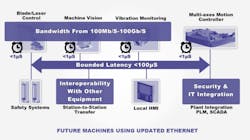The conversation around industrial Ethernet communications is evolving rapidly of late. For years the discussion largely centered on proving the ability and applicability of Ethernet in industry. It seems that the idea of Ethernet in industry has finally achieved critical mass and the discussion has now shifted focus to standardization and certification.
In my most recent post on industrial Ethernet standardization, I wrote about the HyperCat Consortium and its efforts to standardize machine-to-machine communications for the expected explosion of Internet of Things applications using Ethernet-based networks. Now comes news that the AVnu Alliance—known for its work in the consumer, pro audio/visual and automotive industries around standards-based deterministic networking certifications—is now turning its attention to the industrial market in general.
The principal focus for AVnu Alliance in the industrial sector stems from the evolution of the Audio/Video Bridging (AVB) concept for Ethernet into Time-Sensitive Networking (TSN)—as evidenced by changes in the IEEE 802.1 working group, which changed its name to the “Time-Sensitive Networking Task Group” from “Audio/Video Bridging Task Group” in November 2012.
According to AVnu Alliance, “the new capabilities of TSN provide the industrial community with the ability to use standard Ethernet to support highly reliable and precise synchronized networking appropriate for industrial control.”
While all this sounds interesting, the real story at this early stage in the process is the support AVnu Alliance has already received from major industrial automation players around its TSN for industrial control initiative. Belden, General Electric and National Instruments have all recently joined AVnu Alliance’s Industrial Control group to help AVnu and IEEE 802 create updates to standard Ethernet that will provide for:
* Bounded, low-latency data transfer for control applications;
* Shared synchronized time;
* High bandwidth;
* Convergence of control traffic and standard Ethernet traffic; and
* Security enhancements aligned with IT standards.
“These improvements will enable a single network to support reliable, multi-kHz closed-loop control and dynamic un-managed standard Ethernet traffic,” according to AVnu. “Because these capabilities are being incorporated in the core Ethernet standard, these upgrades promise broad adoption, increased flexibility, increased bandwidth, multi-vendor interoperability, and decreased cost.”
Existing AVnu Alliance members such as Broadcom, Cisco, Intel, Interval Zero, Marvell, Micrel, Vitesse, Xilinx and XMOS also support AVnu’s new industrial segment.
The criticality of AVnu Alliance’s work in this area was underscored by the comments of John Garrity, product line leader for General Electric Intelligent Platforms, when he said, “Since AVnu Alliance is the only community consortium driving the expansion of AVB and TSN standards, we are excited to join and offer our expertise to the efforts.”
"TSN technology shows promise to be the core technology for high-end industrial Ethernet communications in the future, solving challenges … in demanding, high-performance and high-precision industries, like motion control, robotics and high-speed manufacturing,” added Andreas Dreher, strategic technology manager at Belden.
Mike Santori, vice president of product marketing at National Instruments, noted that “TSN promises, through standard silicon, to converge the previously disparate technologies needed for standard Ethernet communication, for deterministic high-speed data transfer, and for high-accuracy time synchronization. These developments will create a common foundation that will impact numerous applications and markets ranging from machine control and asset monitoring to test cells and vehicle control.”
Leaders relevant to this article:


